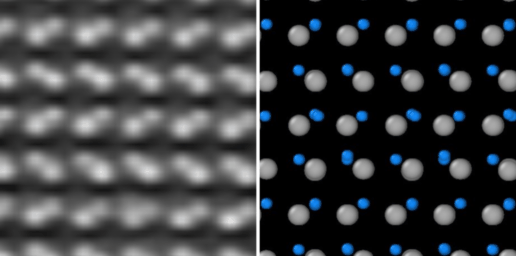
A new family of ferroelectric materials could be used to make more energy-efficient microelectronics devices. This is the finding of researchers at Carnegie Mellon University and Pennsylvania State University, both in the US, who studied how the polarization of crystalline materials called wurtzites switches when an electric field is applied.
The recent observation of ferroelectricity in wurtzites contradicted a 100-year-old belief that these materials were pyroelectric and piezoelectric, and that their polarization could thus not be switched with an electric field. The discovery also sparked interest among electronics engineers because wurtzite-based switches could have applications in logic, memory, high-power, acoustic and electro-optical devices. A further attraction is that wurtzites would be easy to integrate with mainstream semiconductor platforms (including complementary metal-oxide semiconductor or CMOS electronics), making it possible to save energy by changing the architecture of microcircuits.
There is a problem, however. The strength of the electric field required to switch a wurtzite’s polarization, and thus for it to operate as a switch, is dangerously close to the strength of the electric field at which the material breaks down. This does not leave much room for manoeuvre.
Nonpolar polarization reversal mechanism
In the new study, researchers led by Elizabeth Dickey of Carnegie Mellon’s materials science and engineering department studied electric-field-induced polarization switching in a wurtzite composed of aluminium and nitrogen alloyed with boron (chemical formula Al0.94B0.06N). The team used scanning transmission electron microscopy to image columns of aluminium, boron and nitrogen atoms as they move in response to the field. Atomistic calculations performed by Ismaila Dabo and colleagues at Penn State helped the team fully interpret this experimental data and use it to glean information about the material’s energy landscape during the switching process.
The team’s analysis, which is detailed in Science, reveals a polarization reversal mechanism in which puckered aluminium/boron nitride bonds adopt alternating polarities, such that the net polarity is zero. These alternating polarities come about thanks to the presence of the boron, which creates significant structural distortions over small distances. These disordered domains then provide low-energy pathways that nucleate a switching process that is mediated by the nonpolar state. Such switching is absent in aluminium nitride films not alloyed with boron, the researchers say.

Thinner antiferroelectrics become ferroelectric
“Understanding the atomic-scale structure in this class of materials and how this structure affects polarization reversal (ferroelectric switching) will help us better understand how to further refine the properties of these structures via compositional or microstructural engineering,” Dickey says. “This will allow us to ultimately lower the electric field under which these materials switch, which is a limiting factor in moving them into applications.”
The researchers are now applying their experimental approach to other novel ferroelectric materials for which theory predicts that switching pathways will exist. “We also aim to use our method to understand how interfaces, such as electrode interfaces, modify the ferroelectric domain nucleation,” Dickey tells Physics World.



